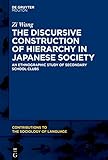The Discursive Construction of Hierarchy in Japanese Society : An Ethnographic Study of Secondary School Clubs / Zi Wang.
Material type: TextSeries: Contributions to the Sociology of Language [CSL] ; 116Publisher: Berlin ; Boston : De Gruyter Mouton, [2020]Copyright date: ©2020Description: 1 online resource (X, 213 p.)Content type:
TextSeries: Contributions to the Sociology of Language [CSL] ; 116Publisher: Berlin ; Boston : De Gruyter Mouton, [2020]Copyright date: ©2020Description: 1 online resource (X, 213 p.)Content type: - 9781501518621
- 9781501514593
- 9781501514876
- 495.68 23
- PL524.75 .W36 2020
- online - DeGruyter
- Issued also in print.
| Item type | Current library | Call number | URL | Status | Notes | Barcode | |
|---|---|---|---|---|---|---|---|
 eBook
eBook
|
Biblioteca "Angelicum" Pont. Univ. S.Tommaso d'Aquino Nuvola online | online - DeGruyter (Browse shelf(Opens below)) | Online access | Not for loan (Accesso limitato) | Accesso per gli utenti autorizzati / Access for authorized users | (dgr)9781501514876 |
Frontmatter -- Contents -- 1 Introduction: Contextualising jouge kankei -- 2 Studying the discursive construction of jouge kankei in secondary school clubs -- 3 Ideologies, power, text, and discourse: Bukatsudou as sites of learning and socialisation in language and discourse -- 4 Address terms, honorific word choices, and the construction of hierarchy -- 5 The linguistic constitution of jouge kankei: Ideology in micro-level discourse and epistemic orders -- 6 Space, signs, symbols, and objects used in conjunction with discourse -- 7 Jouge kankei: Discursive construction, characteristics, implications and future outlook -- Appendix 1: Junior High School Curriculum Guidelines, Published by the Ministry of Education, Culture, Sports, Science and Technology (MEXT) -- Appendix 2: Guidelines for codes of conduct in extra-curricular club -- Appendix 3: On the Romanisation of Japanese -- Appendix 4: Glossary of Japanese Terms -- Appendix 5: List of Standard Abbreviations used according to the Leipzig Glossing Rules -- References -- Index
restricted access online access with authorization star
http://purl.org/coar/access_right/c_16ec
Seniority-based hierarchy (jouge kankei) is omnipresent in Japanese group dynamics. How one comports, depends on one’s status and position vis-à-vis others. To-date, no study shows what constitutes this hierarchy, where and when individuals growing up in Japan first come into contact with it, as well as how they learn to function in it. This book fills in the lacunae. Considering jouge kankei as a social institution and adopting a discourse analytic approach, this volume examines the ways in which institutional jouge kankei as an enduring feature of Japanese social life are created and reproduced. The monograph analyses how seniority-based relations are enacted, legitimised, transmitted, and reified by social actors through language use and paralinguistic discursive practices, such as the use of space, objects, signs, and symbols. It also looks at how established rules could be challenged. The empirical data on which findings are based are gathered through 10 months of ethnographic fieldwork from 2015 to 2018 in Japanese schools, with certain types of data (school club etiquette books and uniforms) being presented and analysed for the first time. This volume also shows continuity and change of jouge kankei from school to work.
Issued also in print.
Mode of access: Internet via World Wide Web.
In English.
Description based on online resource; title from PDF title page (publisher's Web site, viewed 25. Jun 2024)


